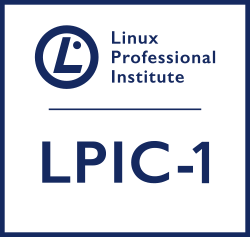101-500

| Formats: | Asynchronous |
| Blended | |
| Online | |
| Onsite | |
| Part-time | |
| Level: | Beginner |
| Prerequisites: | |
| Recommended Knowledge | |
| Basic familiarity with computer hardware and operating systems. | |
| An introductory understanding of Linux or Unix concepts | |
| Access to a Linux environment for hands-on practice. | |
| Linux Essentials | |
Formats: We offer our training content in a flexible format to suit your needs. Contact Us if you wish to know if we can accommodate your unique requirements.
Level: We are happy to customize course content to suit your skill level and learning goals. Contact us for a customized learning path.
LPIC1 101 (101-500)
The LPIC-1 certification is a globally recognized, vendor-neutral credential that validates the skills required to administer and maintain Linux systems. To earn the LPIC-1 certification, candidates must pass two exams: LPIC-1 101 and LPIC-1 102. This course focuses on the LPIC-1 101 exam, covering foundational Linux administration skills such as system architecture, installation, package management, and command-line operations. Whether you're managing servers or desktops, this course equips you with the knowledge to work with any Linux distribution.
Target Audience
This course is ideal for:
- IT professionals seeking to start a career in Linux system administration.
- System administrators transitioning to Linux from other operating systems.
- Technical enthusiasts eager to master Linux fundamentals.
- Anyone preparing for the LPIC-1 101 certification exam.
Prerequisites
To succeed in this course, participants should have:
- Basic familiarity with computer hardware and operating systems.
- An introductory understanding of Linux or Unix concepts (preferred but not required).
- Access to a Linux environment for hands-on practice.
What You Will Learn
In this course, you will gain expertise in:
- Configuring and managing Linux system architecture and hardware settings.
- Installing Linux, managing boot processes, and handling package management.
- Mastering essential GNU and Unix command-line tools and techniques.
- Managing devices, filesystems, and adhering to the Filesystem Hierarchy Standard.
Benefits of the Course
By completing this course, you will:
- Develop the skills to administer Linux systems effectively.
- Gain a strong foundation for passing the LPIC-1 101 exam.
- Enhance your employability in roles requiring Linux expertise, such as system administration and cloud support.
- Build confidence in working with any Linux distribution in a vendor-neutral context.
Course Outline
- System Architecture
- Determine and configure hardware settings
- Boot the system
- Change runlevels / boot targets and shutdown or reboot system
- Linux Installation and Package Management
- Design hard disk layout
- Install a boot manager
- Manage shared libraries
- Use Debian package management
- Use RPM and YUM package management
- Linux as a virtualization guest
- GNU and Unix Commands
- Work on the command line
- Process text streams using filters
- Perform basic file management
- Use streams, pipes, and redirects
- Create, monitor, and kill processes
- Modify process execution priorities
- Search text files using regular expressions
- Basic file editing
- Devices, Linux Filesystems, Filesystem Hierarchy Standard
- Maintain the integrity of filesystems
- Control mounting and unmounting of filesystems
- Manage file permissions and ownership
- Create and change hard and symbolic links
- Find system files and place files in the correct location
Please contact us for any queries via phone or our contact form. We will be happy to answer your questions.
Ferndale,
2194 South Africa
Tel: +2711-781 8014 (Johannesburg)
+2721-020-0111 (Cape Town)
ZA
Jumping Bean Contact Form!